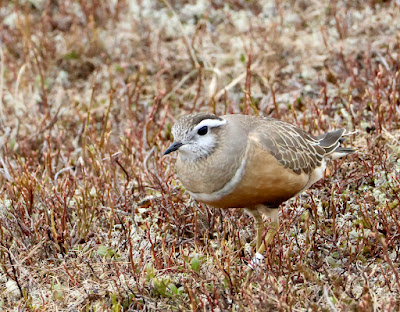It was May 28th and we came here, to Inari--Saariselkä Kaunispää in Lapland, for one bird. It was a bird everyone wanted to see. Kaunispää (437 m) is one of the highest arctic hills near the Saariselkä village and the only one that can be reached by car. We arrived at a large, tundra-like landscape and got out of the vans to begin our search. It was cold, windy and raining. We walked around for a while and then I heard one of our guys whistle. He waved his arms. "Hey you guys, we're being called." I didn't know what he found, but I was closest to the spot he was calling from and I took off. I slowed down as I got closer. It was too windy and rainy to shout over. Suddenly, I saw what it was. The Eurasian Dotteral (Eudromias morinellus). Moss had stepped very near the nest and the bird popped up leaving three eggs exposed. He took a photo of the eggs.
Back on the nest!
I can't remember if it was Nigel or Anttu but one, or both of them, took turns explaining this bird's breeding strategy. The female bird is somewhat more brightly colored.
The Eurasian Dotterel exhibits a polygynandrous breeding strategy, specifically with serial polyandry. Female Eurasian Dotterels arrive at breeding grounds and establish mating territories, competing with other females for access to males. Females are polyandrous, mating with multiple males, while males typically incubate the eggs and care for the young. This means the female lays multiple clutches, usually of three eggs, with different males and the male is left to raise the chicks from his clutch. Our bird was sitting on his three eggs.
There are many on-line sites where photos of the Eurasian Dotteral and its mating strategies are discussed. I'm not a Birds of the World subscriber, but for those who are it's probably a satisfying deep dive. eBird also has a good write-up with a good range map. There are many others.
A scientific paper (1983) by two Norwegian researchers, Breeding Chronology and Mating System of the Eurasian Dotteral (Charadrius morinellus) was published in The Auk, and is available for free from The Digital Commons at the University of South Florida. Of note: the Dotterel's genus was relatively recently changed from Charadruis to Eudromias.
True enough, the paper above is old, but it's also free. It suggests that the female Dotterel may remain in the same area and breed with another male. However, both Nigel and Anttu suggested that the departed female Dotterels can travel quite far to their next breeding sites. The male will stay behind to incubate and take care of his offspring. I am guilty of anthropomorphism, not always but occasionally, especially when it's something that really appeals to me. This was one of those things. One of the other trip members was a wildlife biologist who had done a lot of work with birds, although ornithology was not her area of expertise. We often sat together in the rear seat of the van. I admitted to my anthropomorphism and commented how content the male Dotterel appeared on his nest. Contentment is a human emotion. But, she agreed with me and went further with other examples of how research is opening doors where we are beginning to understand anthropomorphism differently. Specifically about our Dotterel - incubating his eggs is his whole goal in life. It is well understood that birds have hard lives. This bird had flown thousands of miles precisely to do what he was doing on the day we saw him. He deserved some contentment which, in his case, is being a successful breeder. I was worried that every birder in Finland would make a visit to see the Dotterel and his nest would fail. But Anttu disagreed saying this Dotterel had been a successful breeder for the past couple of years. Finnature will, apparently, monitor this. Anttu may take part in this monitoring. I worried less.
In the 2nd edition of Birds of Europe, the author wrote this about the male Dotterel: "Nest is a bare scrape. Male does most of incubation and care of young. Some males are extremely tame just before eggs hatch" (page 142). It's the last sentence that caught my attention.
On the list of my five favorite birds I put the Eurasian Dotterel in my number two spot. My number one bird is still coming up. But, after looking at my photos again and writing this blog entry, I wish I had made the Dotterel my number one. On any trip there always seems to be one bird that I become attached to. On this trip it was this bird.
Addendum on 07/08/2025
Yesterday I emailed Anttu Topp (our Finnature guide) to inquire about the success of the Dotterel. This morning I received Anttu's reply as follows and he further clarifies some of the information above:








1 comment:
I like your thoughts about anthropomorphism. Somehow, any criticism of this to me often fails to see that humans are animals - so if we humans derive specific feelings from instinct-driven behavior, why shouldn't it be the same for birds? Thus, not anthropomorphizing almost seems to distinguish humans from other animals in a way we clearly do not deserve.
Post a Comment